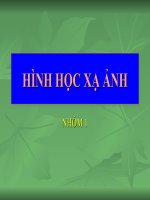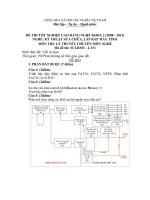PASSAGE 31
Bạn đang xem bản rút gọn của tài liệu. Xem và tải ngay bản đầy đủ của tài liệu tại đây (44.25 KB, 2 trang )
PASSAGE 31
Simply being bilingual doesn’t qualify someone to interpret. Interpreting is not only a mechanical process
of converting one sentence in language A into the same sentence in language B. Rather, its a complex art
in which thoughts and idioms that have no obvious counterparts from tongue to tongue - or words that
have several meanings must be quickly transformed in such a way that the message is clearly and
accurately expressed to the listener.
At one international conference, an American speaker said, “You can’t make a silk purse out of a sows
ear”, which meant nothing to the Spanish audience. The interpretation was, “A monkey in a silk dress is
still a monkey” - an idiom the Spanish understood and that expressed the same idea.
There are 2 kinds of interpreters, simultaneous and consecutive. The former, sitting in a separated booth,
usually at a large multilingual conference, speaks to listeners wearing headphones, interpreting what a
foreign language speaker says - actually a sentence behind. Consecutive interpreters are the ones most
international negotiations use. They are employed for smaller meetings without sound booths and
headphones. Consecutive interpretation also requires two-person teams. A foreign speaker says his piece
while the interpreter, using a special shorthand, takes notes and during a pause, tells the client what was
said.
Question 1. What is the purpose of the passage?
A. To differentiate between simultaneous and consecutive interpreters.
B. To state the qualifications of an interpreter.
C. To point out the importance of an interpreter.
D. To explain the scope of interpreting.
Question 2. What is a difference mentioned between a simultaneous interpreter and a consecutive
interpreter?
A. The size of group with whom they work.
B. Their proficiency in the language.
C. The type of dictionary they use.
D. The money they are paid.
Question 3. A precondition of being a translator is_____.
A. being able to use high-tech equipment
B. being a linguist
C. being bilingual
D. working well with people
Question 4. What would a simultaneous interpreter be most in need of?
A. Headphones and a booth.
B. Shorthand skills and a notepad.
C. A dictionary or phrase book.
D. Advanced technical style in writing.
Question 5. The word “converting” in paragraph 1 is closest in meaning to_____.
A. changing
B. concluding
C. understanding
D. reading
Question 6. The author implies that most people have the opinion that the skill of interpreting is ______.
A. very complex and demanding
B. based on principles of business
C. simpler than it really is
D. highly valued and admired
Question 7. The phrase “the former” in paragraph 3 refers to_____.
A. simultaneous interpreters
B. the conference
C. consecutive interpreters
D. the booth
Question 8. Which of the following would a consecutive interpreter be used for?
A. An interpretation of a major literary work.
B. A business transaction between 2 foreign speakers.
C. A large meeting of many nations.
D. A translation of a foreign book.
ĐÁP ÁN
1-D
2-A
3-C
6-A
7-A
8-B
4-A
5-A
LỜI GIẢI CHI TIẾT
Question 1:
mục đích của đoạn văn này: để giải thích phạm vi của interpreting.
Question 2:
thơng tin nằm ở toàn bộ đoạn này: There are 2 kinds off interpreters, simultaneous and consecutive. The
former, sitting in a separated booth, usually at a large multilingual conference, speaks to listeners wearing
headphones, interpreting what a foreign language speaker says actually a sentence behind. Consecutive
interpreters are the ones most international negotiations use. They are employed for smaller meetings
without sound booths and headphones. Consecutive interpretation also requires two-person teams. A
foreign speaker says his piece while the interpreter, using a special shorthand, takes notes and during a
pause, tells the client what was said.
Question 3:
thông tin nằm ở đoạn này: Simply being bilingual doesn’t qualify someone to interpret. Interpreting is not
only a mechanical process of converting one sentence in language A into the same sentence in language
B. Rather, it’s a complex art in which thoughts and idioms that have no obvious counterparts from tongue
to tongue – or words that have several meanings must be quickly transformed in suck a way that the
message is clearly and accurately expressed to the listener.
Question 4: thông tin nằm ở đoạn này: The former, sitting in a separated booth, usually at a large
multilingual conference, speaks to listeners wearing headphones, interpreting what a foreign language
speaker says actually a sentence behind. Consecutive interpreters are the ones most international
negotiations use. They are employed for smaller meetings without sound booths and headphones.
Question 5: converting = changing
Question 6: đọc đoạn đầu và cuối, ta có thể suy ra rằng, tác giả ngụ ý rằng phần lớn mọi người có quan
điểm là kỹ năng phiên dịch rất phức tạp và yêu cầu cao.
Question 7:
the former = simutaneous interpreters, thông tin nằm ở đây: There are 2 kinds of interpreters,
simultaneous and consecutive. The former, sitting in a separated booth, usually at a large multilingual
conference, speaks to listeners wearing headphones…
Question 8:
thông tin nằm ở đoạn này: Consecutive interpreters are the ones most international negotiations use. They
are employed for smaller meetings without sound booths and heaphones. Consecutive interpretation also
requires two – person teams. A foreign speaker says his piece while the interpreter, using a speacial
shorthand, takes notes and during a pause, tells the client what was said.









